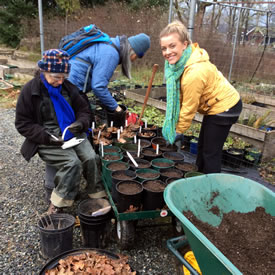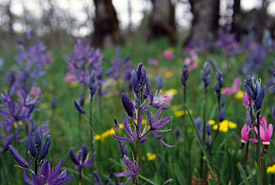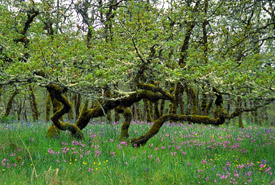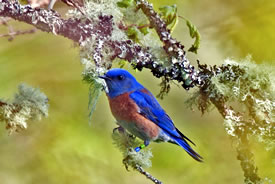Caring for babies at the Cowichan Garry Oak Preserve

Maxine Leichter lends a hand during a Conservation Volunteers event at CGOP (Photo by NCC)
What does an environmentalist grandmother do who lives thousands of miles from her grandchildren? She takes care of baby plants instead at the Nature Conservancy of Canada’s (NCC's) Cowichan Garry Oak Preserve (CGOP) near Quamichan Lake and Duncan. That’s me! Once a week I join a small group of volunteers in helping to raise juvenile rare and endangered plant species growing in the preserve’s nursery.
The plants are grown from seeds gathered on the preserve, which are started in small pots or long tubes then potted up (often by volunteers) into larger containers. Removing all the weeds from thousands of potted plants in the nursery is a major task in the fall. Our special charges include baby California brome (a native grass), the wildflowers deltoid balsam root, Howell’s triteleia and chocolate lily bulbs, as well as many other blue- and red-listed species such as white-top aster, Oregon ash and yellow prairie violet. Eventually, these will all be planted out in the grounds of the preserve, as part of a program guided by many years of scientific research conducted at the site.

Cowichan Garry Oak Preserve flowers, BC (Photo by Tim Ennis/NCC)
Except for occasional events, the preserve is closed to the public in order to facilitate research and to protect the numerous rare species. Volunteers can take short walks through the preserve and enjoy great opportunities to watch the progression of the Garry oak ecosystem through the seasons, including the spectacle of millions of blooming camas in the spring.

Garry oak, Cowichan Garry Oak Preserve, BC (Photo by Tim Ennis/NCC)
The preserve shelters 26 acres (11 hectares) of Garry oak woodland and 27 acres (11 hectares) of open savannah grasslands dotted with unbelievably huge Garry oak trees. The view of these grasslands sloping down to Quamichan Lake is quite spectacular. Irvin Banman, who supervises the preserve, says that the open savannah is what most of the surrounding area was once like, back when First Nations people cultivated it for camas bulbs and used fire as a tool, maintaining the open meadow-like structure with controlled burns.

Western bluebird (Photo by Bill Pennell)
CGOP is also prime habitat for the rare western bluebird, so in recent years over 60 of these lovely little birds have been re-introduced to the site, a few at a time, from populations in Washington State. The new arrivals are closely monitored by biologists and volunteers for successful rearing of their young.
If you too could spare some time and energy to care for babies (of many species!), to plant them out, gather seeds, re-move invasives and other tasks, both at CGOP and on Salt Spring, please join us.


